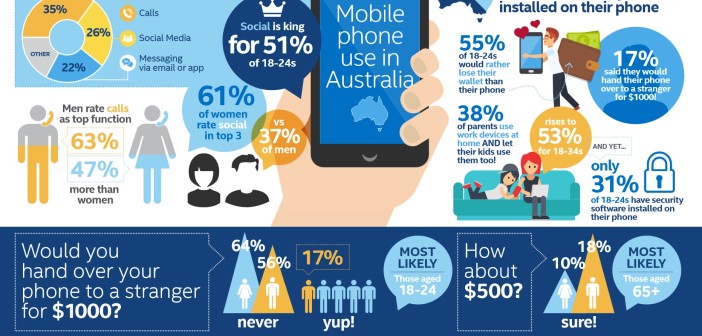
With approximately 21 million mobile handset subscribers in Australia (Kantar WorldPanel), Australia is 2nd in the world for smartphone ownership, behind South Korea (Pew).
But according to new research of over 1,000 Australian adults by Intel Security in time for the Government’s Stay Smart Online Week (10th – 14th October), despite a majority (60%) viewing their mobile phone as ‘priceless’, nearly two thirds (65%) do not have any security software installed to protect them.
And mobile malware is on the rise – which means a minimum of 14m have minimal security which could put them at increased risk of attacks. Every hour, Australian mobiles receive between 10-100 malware threats (according to McAfee Labs 2016).
Latest analysis of mobile malware from Intel Security’s McAfee Labs (Sept 2016), found that mobile malware has grown 151% over the past year, and the number of new mobile malware samples was the highest ever-recorded in Q2 2016.
Assets
• Voxpops – video of opinions from Australians and their mobile usage http://bit.ly/2dCuBCg
• Infographic of main research outcomes
• Commentary and opinion on security available from Intel Security Solutions Architect Andy Hurren
Intel Security Research Highlights:
Top three functions for Australians using mobile phones
1. Calls (35%)
2. Social Media (26%)
3. Messaging via email or apps (22%)
Males versus Females:
• Males are calling more than females – 63% of men rated calls as their top function, compared with 47% of females
Across the ages:
• Only 1 in 20 Australians aged 18-24 are using their phone for calls (5%)
• 18-24 year olds rule for social media usage (51%) – but 4% of 65+ year olds are using social media often
Geo differences:
• Calls remains the most widely used function throughout Australia, except for in WA, ACT & NT where messaging is highest
How much money it would take Australians to hand over their phones to a stranger?
• Our phones are a treasured possession – 60% would never give up their phone to a stranger as the content is ‘priceless’
• Nearly 1 in 5 (17%) would hand over their phone to a stranger if offered over $1,000
Males versus Females:
• Two thirds of women (64%) said they would ‘never’ give up their phone to a stranger, compared with just over half of men (56%)
• Only 1 in 10 women would take $500 for it, compared with nearly a quarter (18%) of men
Across the ages:
• Those aged 18-24 are most likely to take $1,000 for their phone (27%) but those aged 65+ were most likely to take just $500 for it (17%)
Geo differences:
• Mobile users in TAS are the most likely to hand over their phone for a sum of money (52%), whilst in all other states the majority of residents consider their phone too valuable to hand over
Over a third of Australians (35%) would rather lose (or have stolen) their wallet rather than their phone
Males versus Females:
• More women than men would rather lose their wallet than their phone (39% versus 30%)
Across the ages:
• Younger Australians are the only age group that would rather lose their wallet than their phone (55% of those aged 18-24)
Geo differences:
• Residents in the ACT value their phone over their wallet the most compared to other states with almost half (47%) preferring to lose their wallet than their phone
Nearly two thirds of Australians mobiles don’t have security software installed (65%)
Males versus Females:
• Australian males are more protected than women – nearly 2 in 5 men compared with only a third of women (38% v 32%)
Across the ages:
• Those aged 45-54 are the most protected (40%) and younger 18-24 year olds are the least protected (31%)
Geo differences:
• Tasmanians are the least protected when it comes to mobile security with less than a third of residents having security software installed on their phone (26%)
• Residents in the ACT are the most protected with almost half of consumers using mobile security (47%)
Bring Your Own Device: Over a third of Australians with children (38%) use their work device at home/connected to their home network and also allow their children to use that device
Males versus Females:
• Australian females with children (40%) are more likely to let their child use their work device at home/connected to the home network than males (36%)
Across the ages:
• Of Australians with children, 53% of both 18-24 and 25-34 year olds use their work device at home/connected to their home network and also allow their children to use that device. This drops to 46% in the 35-44 year old category
Geo differences:
• Residents in the NT with children are most likely to use and let their child use their work device at home/connected to the home network (56%), whilst residents in the ACT with children are least likely (24%)
Intel Security offers the following tips for protecting your mobile ‘from the lounge room to the boardroom’:
1. Create a strong, unique (and private!) password for every device that is more than 4 characters long with a mix of upper and lower case letters, numbers and special characters. Use multi-factor authentication where available
2. Back up your mobile device regularly to avoid data loss
3. Only download apps from trusted stores and read reviews beforehand
4. Double check the authenticity of ‘Free Wi-Fi’ networks in public spaces
5. Choose security software that lets your protect multiple devices and update these regularly for the latest protection. McAfee’s latest Total Protection offers multiple device protection for your household
About the study:
The research was conducted online by Pure Profile through a national sample of over 1,000 Australian residents over the age of 18. The interviews were conducted from 23rd – 27th September 2016.






